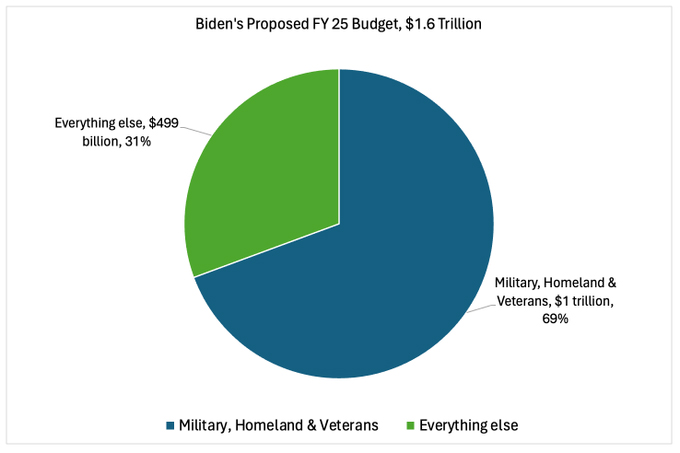By Lindsay Koshgarian, National Priorities Project, March 13, 2024
Today the White House released President Biden’s budget proposal, including a proposal for $1.6 trillion in discretionary spending for FY 2025, which begins on October 1, 2024.
While the larger budgets makes some important strides forward, this discretionary proposal won’t provide security we need, in terms of costs of living, quality of life, climate change, or securing peace:
- According to figures released by the administration, militarism and its support systems (such as veterans’ programs) account for $1.1 trillion in the proposal, while domestic spending programs account for less than half that, at $499 billion.
- That means that $69 out of every $100 federal dollars in this proposal go toward militarization and its support systems, including the military, homeland security, and veterans affairs.
- And it leaves just $31 out of every $100 for everything else in the discretionary budget: from housing programs to public education, public health, environmental protection, and more.
According to the administration’s figures, militarized funding in the proposal totals $1.1 trillion for FY 2025, and includes:
- $850 billion for the Pentagon
- $34 billion for nuclear weapons
- $11.6 billion in international military aid (so far)
- $62 billion in non-emergency funding for the Department of Homeland Security, including $9.3 billion for Immigration and Customs Enforcement (ICE) and $17 billion for Customs and Border Protection (CBP)
- $113 billion for Veterans’ Affairs Medical Programs.
That’s not all the militarism in the budget. In reality, the spending on militarization in this budget is even higher. These figures, which come from the administration, treat the militarization of domestic law enforcement – things like the domestic work of the FBI, federal marshalls, and grants to local law enforcement agencies – as domestic expenses. NPP reports from previous years have found that those expenses added tens of billions more in militarized spending.
And it doesn’t include war spending. Just as important, the proposal includes only $12 billion for direct international military aid, and nothing for the Pentagon’s operations in support of various wars. That’s highly unrealistic given current administration policies. In FY 2023, the U.S. spent $29 billion on international military aid and another $35.8 billion on Pentagon support for allies (primarily Ukraine). For FY 24, the administration has requested (but Congress hasn’t yet enacted) an additional $7 billion in direct military aid to countries including Ukraine and Israel, plus another $58 billion in Pentagon spending to support those countries’ military efforts. (The White House release today is consistent with those figures).
Unless the administration changes approach, these wars will continue to cost us. The administration hasn’t been making visible efforts to end the war in Ukraine, nor has it responded to demands that it withhold military aid to Israel in light of war crimes the Israeli government continues to perpetrate there. Without – at the very least – some efforts along those lines, it’s not reasonable to assume these extra expenses will just drop to zero next year.
There’s not enough left for programs we need. The president’s larger proposal includes important steps forward for things like childcare and help for families with children. But compared to FY 2023 (the last year with a budget fully enacted by Congress), this proposal increases Pentagon spending by $33.8 billion while:
- Cutting spending on Veterans’ Affairs and the Department of Transportation, and providing minimal increases (often lower than the rate of inflation) for other programs and departments.
- Increasing the Pentagon’s budget by more than 10 times that of the Department of Education ($3.1 billion); 7 times that of the Department of Health and Human Services ($4.8 billion); and 330 times that of the State Department ($0.1 billion).
That last one is a doozy – if we are ever going to stop the cycle of endless war, we’ll have to invest differently.
All figures are from the Office of Management and Budget, FY 2025 President’s Budget Request, unless otherwise noted.









